(1)(1).jpg)
Shah Jahan Mosque
Ruqayyah, a third year student at Lancaster writes:
I chose this monument for its remarkable history and breath taking architecture, which echo the far-reaching influence of the Mongol Empire. Still a place of worship today, the mosque continues to inspire awe through its intricacy and exquisite detail. What makes the structure truly unique is its fusion of diverse artistic traditions, a distinctive blend of Sindhi, Persian, Timurid, and Indian architectural styles. This harmonious crossover is especially evident in its vibrant blue hues, which create a mesmerising, kaleidoscopic effect reminiscent of the sea.
The Shah Jahan Mosque of Thatta is located in Thatta, Sindh, Pakistan, and is a 17th-century UNESCO World Heritage site. The mosque was a gift from Emperor Shah Jahan as a gesture of appreciation and gratitude toward the people of Sindh, who offered him refuge during his time in the city. The mosque’s construction was a demanding endeavour that spanned three years. It was personally commissioned by Shah Jahan and is believed to have been overseen by the architect Ustad Hamid. The Shah Jahan Mosque is both a cultural and religious landmark, celebrated for its stunning architectural details. It is constructed from red brick and richly adorned with vibrant blue mosaics and turquoise-glazed tiles. Delicate floral patterns, inspired by 17th-century Kashi art from Iran, decorate its grand arches, while square tiles featuring geometric motifs are arranged in elegant decorative panels. Together, these elements reflect a unique fusion of artistic traditions and craftsmanship.
Moreover, the Shah Jahan Mosque showcases intricate brickwork arranged in geometric patterns, a hallmark of Timurid architecture that is uncommon in Mughal-era mosques. This distinctive brickwork also reflects the influence of Sindhi vernacular styles, themselves shaped by Persian architectural traditions. The most striking examples can be seen in the arcades surrounding the central courtyard, where concentric rings of brick decorate the undersides of the peripheral domes. The mosque features 100 domes, the highest number of domes in any mosque in Pakistan, including six large ones, with the remainder being relatively smaller. The structure also includes 33 arches and, interestingly, lacks even a single minaret. Vents and air passages were strategically designed to ensure that ventilation reached every corner of the mosque. Its architecture was engineered to amplify sound levels to over 100 decibels. This acoustic effect, made possible by the number and design of the domes, allows the recitation of prayers and the khutbah to be heard throughout the mosque. This highlights the advanced architectural knowledge of the time, particularly in the thoughtful integration of sound, ventilation, and lighting. The Shah Jahan Mosque stands as a powerful symbol of Sindh’s rich cultural heritage and holds significant historical value in Pakistan. It reflects the exceptional skill of Mughal architects and craftsmen, blending artistic mastery with spiritual purpose.


